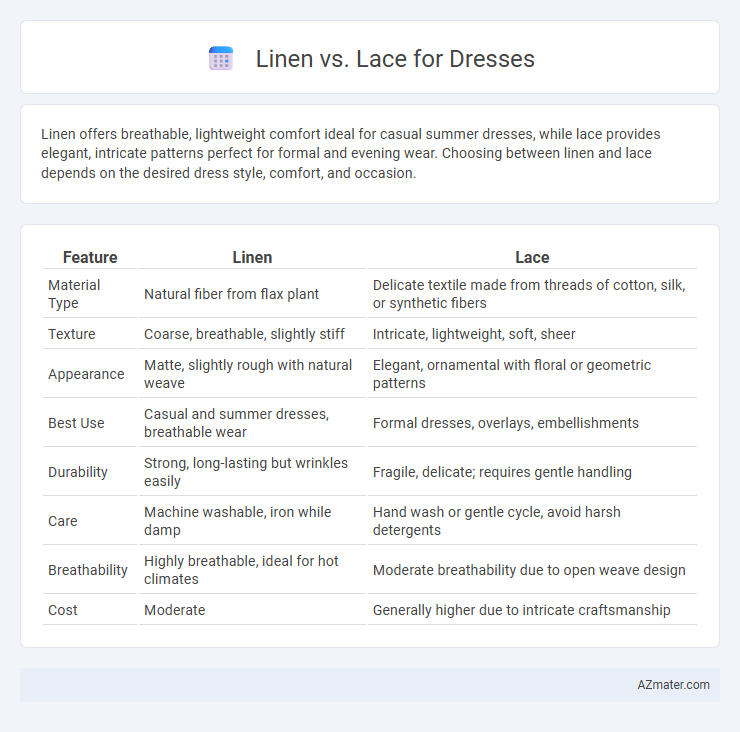Linen offers breathable, lightweight comfort ideal for casual summer dresses, while lace provides elegant, intricate patterns perfect for formal and evening wear. Choosing between linen and lace depends on the desired dress style, comfort, and occasion.
Table of Comparison
| Feature | Linen | Lace |
|---|---|---|
| Material Type | Natural fiber from flax plant | Delicate textile made from threads of cotton, silk, or synthetic fibers |
| Texture | Coarse, breathable, slightly stiff | Intricate, lightweight, soft, sheer |
| Appearance | Matte, slightly rough with natural weave | Elegant, ornamental with floral or geometric patterns |
| Best Use | Casual and summer dresses, breathable wear | Formal dresses, overlays, embellishments |
| Durability | Strong, long-lasting but wrinkles easily | Fragile, delicate; requires gentle handling |
| Care | Machine washable, iron while damp | Hand wash or gentle cycle, avoid harsh detergents |
| Breathability | Highly breathable, ideal for hot climates | Moderate breathability due to open weave design |
| Cost | Moderate | Generally higher due to intricate craftsmanship |
Introduction to Linen and Lace Fabrics
Linen fabric, derived from flax fibers, is renowned for its breathability, durability, and natural texture, making it a popular choice for warm-weather dresses. Lace fabric, crafted from intricate open-weave patterns often using cotton, silk, or synthetic fibers, offers a delicate, elegant aesthetic suited for formal and romantic dress styles. Understanding the unique properties of linen and lace helps in selecting the perfect fabric that balances comfort, style, and occasion.
Historical Background: Linen and Lace in Fashion
Linen, derived from the flax plant, has been used in clothing since ancient Egypt, prized for its durability and breathability, while lace originated in the late 15th century Renaissance Europe, evolving as a luxury fabric symbolizing wealth and refinement. Linen's historical significance is tied to everyday standards and practical wear, contrasting with lace's role in ornamental detailing within aristocratic fashion. Both fabrics have influenced fashion's evolution, reflecting societal values and technological advances in textile production.
Fabric Composition: How Linen and Lace Differ
Linen is a natural fiber derived from the flax plant, known for its breathable, durable, and moisture-wicking properties, making it ideal for warm weather dresses. Lace, typically crafted from cotton, silk, or synthetic fibers, is characterized by its intricate open-weave patterns, offering a delicate and decorative texture rather than structural strength. The key difference lies in linen's solid, sturdy weave versus lace's ornamental, lightweight design, impacting their suitability for different dress styles and occasions.
Texture and Aesthetic Appeal
Linen offers a natural, breathable texture with a slightly coarse yet soft feel, ideal for casual and summer dresses that emphasize comfort and effortless style. Lace provides an intricate, delicate texture characterized by openwork patterns and fine threads, perfect for elegant, romantic dresses with a sophisticated aesthetic. Choosing between linen and lace depends on the desired dress vibe--linen for relaxed, earthy charm and lace for ornate, feminine elegance.
Comfort and Wearability Comparison
Linen offers excellent breathability and moisture-wicking properties, making it ideal for warm weather and all-day comfort, while lace provides a lightweight, decorative option but can be less breathable and rough against the skin. Linen's natural fibers create a soft, durable fabric that becomes more comfortable with wear, whereas lace often requires a lining to enhance comfort and prevent irritation. For practicality and ease of maintenance, linen dresses are more versatile for frequent use, whereas lace dresses are preferred for special occasions due to their delicate nature and aesthetic appeal.
Versatility in Dress Design
Linen offers breathable, lightweight properties ideal for casual and summer dresses, providing natural texture and durability that adapts well to structured or flowy designs. Lace brings intricate patterns and a romantic, delicate feel, perfect for formal, bridal, or eveningwear where embellishment and elegance are key. The contrast in fabric weight and texture allows designers to choose linen for comfort and versatility or lace for decorative, sophisticated aesthetics, catering to diverse dress styles.
Maintenance and Care Requirements
Linen dresses require regular ironing to prevent wrinkles and should be hand washed or machine washed on a gentle cycle with mild detergent to maintain fabric integrity. Lace dresses demand delicate handling, often necessitating hand washing or dry cleaning to preserve intricate patterns and prevent damage. Proper storage in breathable garment bags prevents moisture buildup and fabric deterioration for both materials.
Seasonal Suitability: Linen vs Lace
Linen offers breathability and moisture-wicking properties, making it ideal for warm-weather dresses during spring and summer. Lace, with its intricate patterns and varying weights, provides versatile options suitable for both lightweight spring attire and more layered, elegant fall garments. Choosing between linen and lace depends on the desired balance between comfort and aesthetics across seasonal temperatures.
Cost Considerations and Value
Linen dresses typically offer greater affordability and durability, making them a cost-effective choice for everyday wear and long-term use. Lace dresses, often crafted with intricate patterns and delicate fabrics, come at a higher price point but provide a luxurious, elegant appeal suitable for special occasions. Balancing initial cost with intended use, linen delivers practical value, while lace adds premium aesthetic worth to the wardrobe.
Choosing the Right Fabric: Linen or Lace for Your Dress
Choosing between linen and lace for your dress depends on the occasion and desired comfort; linen offers breathable, lightweight qualities ideal for casual or warm-weather wear, while lace provides an elegant, intricate texture perfect for formal or evening events. Linen's natural fibers enhance durability and ease of care, making it a practical option for everyday or daytime dresses. Lace, often crafted from delicate fibers like cotton or silk blends, adds sophistication but requires more delicate handling and maintenance.

Infographic: Linen vs Lace for Dress
 azmater.com
azmater.com